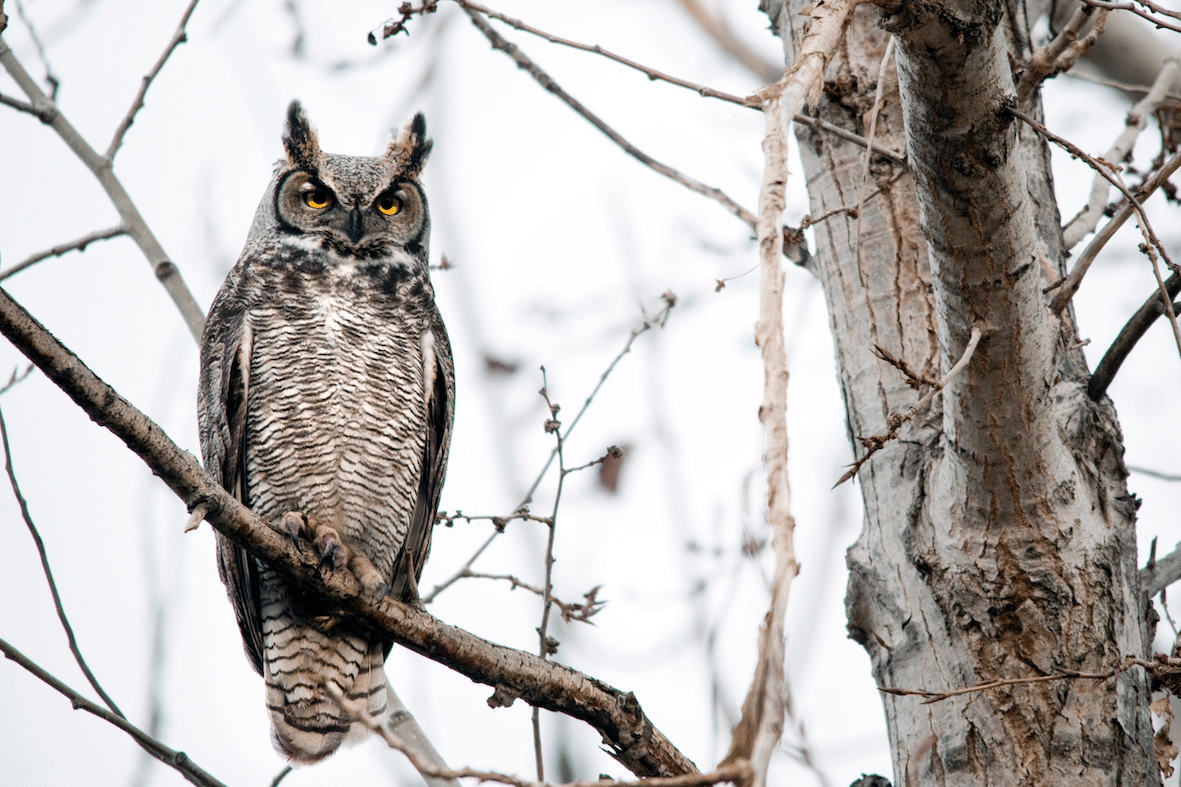Wildlife to Spot as NYC Transitions to Winter
By Natural Areas Conservancy on December 16, 2023

By Natural Areas Conservancy on December 16, 2023

 By Mormei Zanke, Communications Manager
By Mormei Zanke, Communications ManagerYou may think that most of New York City’s wildlife is hunkering down for the cold months, but you can still catch glimpses of fauna in our natural areas! Discover below a list of mesmerizing animals to spot this season and where in NYC to find them.
 Great-horned Owl
Great-horned Owl
As the leaves begin to fall, it becomes easier to spot owls perched on sturdy tree branches. Beginning in late November in mated pairs, great-horned owls will start to defend their nesting territory with hooting duets in the evening and early dawn. Come February, they will lay their eggs (Brrr!).
How to Identify: These large owls will have easy to see “ear” tufts on the top of their head, startling yellow eyes, and gray-to-beige feathers!
Find in these NYC natural areas: Prospect Park (Brooklyn), Goodhue Park (Staten Island), Inwood Hill Park (Manhattan), Pelham Bay Park (Bronx)
 Eastern Gray Squirrel
Eastern Gray Squirrel
You’ve likely seen these playful friends scurrying around NYC’s urban playgrounds. This time of year they are particularly active, as they collect acorns and other tree nuts and seeds. Look way up; those large leafy bundles visible in the bare tree branches are probably gray squirrel homes!
How to identify: Despite their name, gray squirrels can also be brown, rust, or black. It’s likely that if you see a squirrel in NYC it’s the gray squirrel; the less common—and much smaller red squirrel has a deeper orange coat. What usually gives gray squirrels away is their expressive long fluffy tail!
Find in these NYC natural areas: Almost every park! Try these for a guaranteed sighting: Clove Lake Park (Staten Island), Kissena Park (Queens), Marine Park (Brooklyn), Central Par (Manhattan), Riverdale Park (Bronx).
 White-tailed Deer
White-tailed Deer
You may think to spot these large animals you need to be in a rural area, but that’s not the case in NYC! Especially in winter, white-tailed deer become more visible and often can be seen browsing shrubs and nibbling low tree branches on forest edges. Now’s the time to spot bucks with full-grown antlers before they shed them in late winter.
How to identify: In winter, white-tailed deer have a dull brown-gray coat, with white patches of fur on their throat, around their eyes and nose, belly, and of course the underside of their tail!
Find in these NYC natural areas: White-tailed deer have established populations in Staten Island and parts of the Bronx. You may have luck finding them in: Pelham Bay Park (Bronx), Van Cortlandt Park (Bronx), High Rock Park (Staten Island), and Conference House Park (Staten Island).
 Downy Woodpecker
Downy Woodpecker
The downy woodpecker is a great bird to watch as fall becomes winter. As NYC’s smallest woodpecker, they are more agile and can be seen nabbing insects on small stems as well as tree branches and trunks. In winter, they drill into tree bark and search out tasty insect larvae.
How to identify: Follow the tapping sound of their beaks pecking at wood! They have easy to see white spots on their black wings, and the males have a small red spot on the back of his head. You’ll know it’s a downy woodpecker by its size and small bill – the slightly larger (and often confused with) hairy woodpecker has a longer spike-like bill.
Find in these NYC natural areas: Riverside Park (Manhattan), Wolfe’s Pond Park (Staten Island), Seton Falls Park (Bronx), Prospect Park (Brooklyn), Alley Pond Park (Queens).
 Bufflehead
Bufflehead
Winter is an ideal time to see and learn more about waterfowl in NYC’s natural areas. Many ducks and geese gravitate to open water in the city and hang out in groups together. In late fall and winter, you will have a BIG chance to see some species that have flown south, that will later leave in the spring to return north to breed.
One waterfowl to spot is the bufflehead—a small dynamic diving duck! The bufflehead will bop down and pop up from the surface of ponds and lakes to feed underwater.
How to identify: Male buffleheads have a striking black and white appearance from a distance. Their round dark head is dominated by a large white patch. On closer view the dark plumage on their head is actually iridescent purple, green, and blue! The more subtle females are dark brown and gray with a small white patch across the cheek.
Find in these NYC natural areas: Jamaica Bay Wildlife Refuge (Queens), Pelham Bay Park, (Bronx), Marine Park (Brooklyn), Harlem Meer in Central Park (Manhattan), Great Kills Park (Staten Island).

Check out our blog post on the Top 5 Natural Areas to View Fall Foliage in NYC
Read more